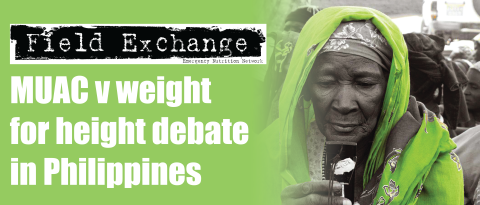En-net update

By Tamsin Walters, en-net moderator
Twenty-seven questions were posted on en-net in the three months up to Christmas, eliciting 102 replies. In addition, 17 job vacancies have been posted.
Recent discussions have included: how to deal with unsolicited donations of breastmilk substitutes (BMS) during the Horn of Africa crisis, measuring undernutrition and vulnerability in older people, the use of different cut-offs for assessing undernutrition in different contexts and countries, how to report uncured registered cases at the end of a communitybased management of acute malnutrition (CMAM) programme within indicators of programme performance, and target weight setting for HIV-positive moderately acutely malnourished children in outpatient therapeutic care.
Two recent questions have sought evidence and guidance on how mid upper arm circumference (MUAC) changes during the treatment of acute malnutrition. These build on previous discussions concerning appropriate exit criteria for CMAM programmes that predominantly use MUAC for admission. A recent study, published in the Nutrition Journal, was conducted in Kenya to quantify MUAC changes among dehydrated children some of whom were malnourished, http://www.nutritionj.com/content/10/1/92. The authors were able to quantify that a one percent (1%) change in weight, was associated with a 0.40 mm change in MUAC.
Examination of data from programme record cards from Community therapeutic care (CTC) programmes during the CTC research programme and in the initial roll-out of CTC / CMAM show a range of median MUAC gains (0.25 mm per day to 0.50 mm per day) . However, these are averages of averages over an entire treatment episode. The rate of change is not consistent over the entire treatment episode and an uncomplicated case of severe acute malnutrition (SAM), typically follows a growth curve with rapid gains early in the treatment episode.
A MUAC study currently being undertaken in Malawi by Valid International is also looking at MUAC and weight changes during treatment of SAM, with results expected later this year. A body of data is building around these issues that could lead to improved future guidance for programme management.
To join the discussion, go to http://www.en-net.org.uk/question/602.aspx.
In the Cross-cutting Issues forum area a call for contributions has been posted for the recently launched ALNAP survey to inform the upcoming ‘State of the Humanitarian System’ Report. A link to the survey can be found at http://www.ennet.org.uk/question/604.aspx. Don’t miss this chance to include your views and ensure that the voices of the emergency nutrition community are well-represented. The survey only takes 7-10 minutes to complete.
Two new forum areas have recently been launched on en-net: Coverage Assessment, http://www.en-net.org.uk/forum/16.aspx (see news piece in this issue of Field Exchange), and Upcoming Trainings, http://www.en-net.org.uk/forum/15.aspx. ENN has received several requests for training on nutrition in emergencies, particularly from within Africa and we hope this forum area will provide a useful place for advertising courses and bringing people together with an interest in developing capacity to respond.
To join a discussion and share your experience or to post a question, visit www.en-net.org.uk
1Mwangome, MK, Fegan G, Prentice AM and Berkley JA. Are diagnostic criteria for acute malnutrition affected by hydration status in hospitalized children? A repeated measures study Nutrition Journal 2011, 10:92
Imported from FEX website


